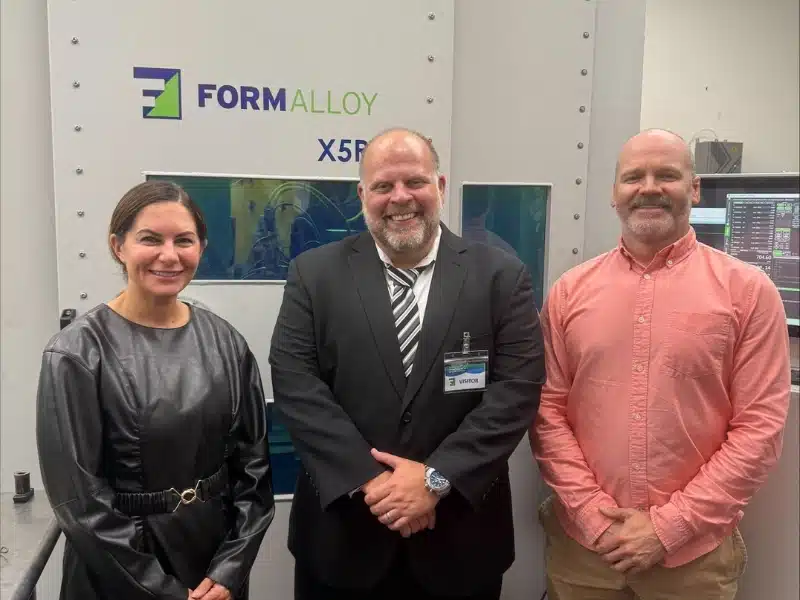Alex Krutz, the Deputy Assistant Secretary for Manufacturing at the U.S. Department of Commerce, stepped into FormAlloy, to look closely at how a small team with lasers is reshaping metal manufacturing.
Why the Deputy Assistant Secretary Came to FormAlloy
Alex Krutz is no stranger to manufacturing. His message was clear: Small businesses like FormAlloy are the production economy.
We couldn’t agree more.
Lasers That Can Replace Castings? Yes.
Let’s talk about castings and forgings. These are the old ways of making big, heavy metal parts. You pour hot metal into a mold. Then you wait. Then you hope it cools right.
It’s worked for years. But it’s slow. Wasteful. And hard to trace.
Now think of a laser. A pile of metal powder or wire. A smart machine. And a metal part growing one perfect layer at a time.
No mold. No guesswork. Just precision.
That’s Directed Energy Deposition (DED). And it’s not a lab trick. It’s a real solution ready to change how we make metal parts—faster, better, and with way less waste.
What Alex Krutz Saw at FormAlloy
We gave Alex the full tour. He saw:
✅ DED Systems in Action – building metal parts in real time
✅ Automated Repair – fixing damaged parts instead of replacing them
✅ Multi-Material Builds – switching materials in one single part
✅ Closed-Loop Monitoring – real-time control, layer by layer
He saw how our small team is doing big things with technology that’s smarter than most factories have ever seen.
And we saw how excited he was about the possibilities.
We’re Ready to Build What the Industry Needs
The manufacturing world is changing. Supply chains are shaky. Casting lead times are long. And skilled labor is hard to find.
The U.S. needs new tools—and new ideas—to stay ahead. And that’s what FormAlloy is building: Smart machines. Automated systems. Metal parts that don’t need months to make.
We’re ready to scale capacity to meet these demands. Not someday. Not if. But now.
DED Is the Answer to More Than One Problem
DED isn’t just for fun projects or test parts. It’s for real-world problems like these:
- 🔩 Need to fix an aerospace part instead of waiting for a new one? DED can scan and repair it, fast.
- 🔩 Want to print a part with a hard outside and soft inside? DED can switch materials mid-build.
- 🔩 Need large-format parts with tight tolerances? DED with robot integration can handle it.
DED doesn’t just replace castings—it beats them. With better control. Less waste. And full traceability.
Small Business. Big Vision. Bigger Impact.
We may be a small team, but we think big. We’re not chasing trends. We’re solving problems. We’re turning complex manufacturing challenges into simple, smart solutions.
And thanks to visits like this—thanks to people like Alex—more leaders are starting to see what’s possible.
The future of metal manufacturing doesn’t belong only to giant factories. It belongs to the teams that dare to do it differently.
And we’re proud to be one of them.
Final Thoughts: A Visit That Meant Something
Alex Krutz’s visit reminded us of something important: What we’re building matters, not just to us, but to the nation.
At FormAlloy, we believe that metal manufacturing can be smarter. Cleaner. Faster. More flexible. And built layer by layer—with lasers, data, and bold thinking.
We’re not waiting for the future. We’re building it. Contact us now.
Curious how DED can change your process?
Explore more at the FormAlloy blog—where we share real applications, smart systems, and stories from the shop floor.
FAQs: Small Teams, Big Machines, and the Future of Manufacturing
- Who is Alex Krutz?
He’s the Deputy Assistant Secretary for Manufacturing at the U.S. Department of Commerce—and a strong supporter of advanced manufacturing.
- Why did he visit FormAlloy?
To learn how small businesses like ours are using laser-based additive manufacturing to improve casting and forging processes.
- What is Directed Energy Deposition (DED)?
DED is a metal 3D printing method that builds parts using a laser and metal powder or wire.
- How is DED better than casting?
DED offers real-time monitoring, faster build times, less waste, and better traceability. It removes the guesswork from metal part production.
- What types of parts can DED build or repair?
From aerospace blades to large-format components and mission-critical tools—DED can both build new parts and repair existing ones.
- Is FormAlloy only for small-scale projects?
No. Our systems scale from R&D to full production and support robotic integration for large builds.
- What makes FormAlloy different?
We combine smart machines, advanced monitoring, and expert support to help manufacturers shift away from old methods like casting.
- Can FormAlloy systems use multiple materials in one build?
Yes! Our powder + wire DED systems can switch materials during the build to create functionally graded parts.
- How can DED support national manufacturing goals?
By shortening supply chains, increasing part repair options, and offering flexible, on-demand production.
- Where can I learn more about FormAlloy’s capabilities?
Right here 👉 formalloy.com or contact us for a tour or demo!

